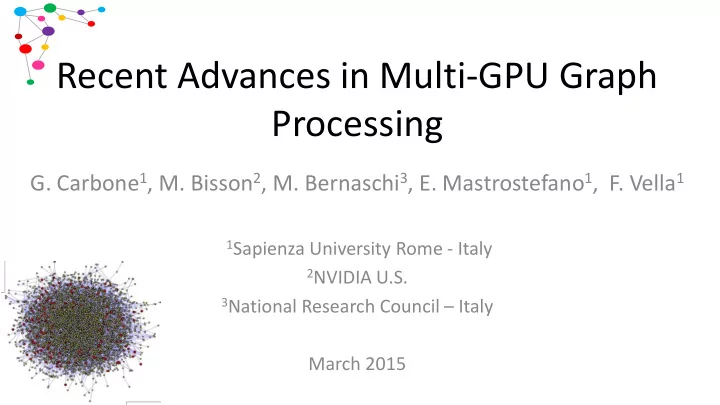

Recent Advances in Multi-GPU Graph Processing G. Carbone 1 , M. Bisson 2 , M. Bernaschi 3 , E. Mastrostefano 1 , F. Vella 1 1 Sapienza University Rome - Italy 2 NVIDIA U.S. 3 National Research Council – Italy March 2015
Why Graph Algorithms • Analyze large networks – Evaluate structural properties of networks using common graph algorithms (BFS, BC, ST-CON, ...) – Large graphs require parallel computing architectures • High performance graph algorithm: – Most of graph algorithms have low arithmetic intensity and irregular memory access patterns – How do GPU perform running such algorithms? – GPU main memory is currently limited to 12GB – For large datasets, cluster of GPUs are required 2
Large Graphs • Large scale networks include hundred million of nodes • Real-world large scale networks feature a power law degree distribution and/or small diameter # Vertices # Edges Diameter wiki-Talk 2.39E+06 5.02E+06 9 com-Orkut 3.07E+06 1.17E+08 9 com-LiveJournal 4.00E+06 3.47E+07 17 soc-LiveJournal1 4.85E+06 6.90E+07 16 com-Friendster 6.56E+07 1.81E+09 32 Source: Stanford Large Network Dataset Collection 3
Distributed Breadth First Search • Developed according to the Graph 500 specifications – Generate edge list using RMAT generator – Support up to SCALE 40 and Edge Factor 16 (where |V| = 2 SCALE and |M| = 16 x 2 SCALE ) – Use 64 bits for vertex representation • Performance metric: Traversed Edges Per Second (TEPS) • Implementation for GPU clusters • Hybrid Programming paradigm: CUDA + Message Passing (MPI and APEnet) • Level Synchronous Parallel BFS • Data structure divided in subsets and distributed over computational nodes 4
1-D BFS • 1-D Graph Partitioning • Balanced thread workload – Map threads to data by using scan and search operations • Enqueue vertices only once (avoiding duplicates) – Local mask array to mark both local and connected vertices • Reduce message size – Communication pattern to exchange predecessor vertices only when BFS is completed avoiding sending them at each BFS level – Use 32 bits representation to exchange vertices instead of 64 bits 5
1-D Results Weak Scaling Plot (RMAT Graph SCALE 21 – 31) 6
2-D BFS • 2-D Graph partitioning – Improved scalability avoiding all-to-all communications • Atomic Operations – Local computation leverages efficient atomic operations on Kepler – 2.3x improvement from S2050 (Fermi) to K20X (Kepler) on single GPU • Further reduction of message size – Use a bitmap to exchange vertices among nodes 7
2-D Results Weak Scaling Plot (RMAT Graph SCALE 21 – 33) 8
2-D Results Weak Scaling Plot (RMAT Graph SCALE 21 – 33) 9
2-D BFS Bitmap based transfer Use bitmap to exchange vertices information With bitmap Without bitmap 10
2D BFS Results on Real Graph* Data Set Name Vertices Edges Scale EF # GPUs GTEPS BFS Levels com-LiveJournal 4.00E+06 3.47E+07 22 9 2 0.77 14 soc-LiveJournal1 4.85E+06 6.90E+07 22 14 2 1.25 13 com-Orkut 3.07E+06 1.17E+08 22 38 4 2.67 8 com-Friendster 6.56E+07 1.81E+09 25 27 64 15.68 24 *Source: Stanford Large Network Dataset Collection 11
ST-CON • Decision problem – Given source vertex s and destination vertex t determine if they are connected – Output the shortest path if one exists • Straightforward solution by using BFS – Start a BFS from s and terminate if t is reached • Parallel ST-CON – Start two BFS in parallel from s and t – Terminate if the two paths meet 12
Parallel ST-CON 1 0 1 2 4 5 2 3 0 1 2 1 7 8 9 6 1 2 1 10 11 12 2 1 0 13
Distributed ST-CON • Atomic-operations based solution – Use atomic operations to update visited vertices – Finds only one s-t path • Data structure duplication solution – Use distinct data structures to track s and t paths – At each BFS level check if there are vertices visited by both – Finds all s-t paths • Performance metric – Number of s-t Pairs Per Second (NSTPS) – Execute ST-CON algorithm over a set of s-t pairs randomly selected 14
ST-CON Results Weak Scaling Plot (RMAT Graph SCALE 21 – 27) 15
ST-CON Results Weak Scaling Plot (RMAT Graph SCALE 19 – 26) Only Parallel Atomic with different Edge Factor 16
ST-CON Results Strong Scaling Plot ( Parallel Atomic) Bernaschi, M., Carbone, G., Mastrostefano, E., & Vella, F. Solutions to the st-connectivity problem using a GPU-based distributed BFS. Journal of Parallel and Distributed Computing, Volume 76, Pages 145-153 February 2015 17
Betweenness Centrality Misure of the influence of a node in a given network used in network analysis, transportation networks, clustering, etc. 𝐶𝐷(𝑤) = 𝜏 𝑡𝑢 (𝑤) 𝜏 𝑡𝑢 𝑡≠𝑢≠𝑤 • σ st is the number of shortest paths from s to t • σ st (v) is the number of shortest paths from s to t passing through v • Best known sequential algorithm requires O( mn ) time-complexity and O(n+m) space-complexity (Brandes2001) • No satisfactory performance for large-scale graphs (biology systems and social networks) 18
Distributed BC • Parallel distributed based on Brandes algorithm Dependency is: BC scores become: 𝜏 𝑡𝑤 𝜀 𝑡 (𝑤) = (1 + 𝜀 𝑡 𝑥 ) 𝐶𝐷(𝑤) = 𝜀 𝑡 (𝑤) 𝜏 𝑡𝑥 𝑥 ∈ 𝑇𝑣𝑑𝑑(𝑤) 𝑡≠𝑤 • 2D BFS as building block • Distributed dependency accumulation • Preliminary results - R-MAT graph Scale 21 with 2M nodes and ≈ 32M Edges requires about 20 hours on 4 K40 GPUs !! 19
Conclusions • Best algorithm has still O( mn ) complexity • Reduce n – 1- degree reduction (≈ 15% on R -MAT) Saríyüce2013, Baglioni2012 – 2-degree reduction (≈ 8% on R-MAT) – Further heuristics to reduce the size of the graph to be analyzed • Improve parallelism – Multi-source BFS 20
Thank You! giancarlo.carbone@uniroma1.it Please complete the Presenter Evaluation sent to you by email or through the GTC Mobile App. Your feedback is important! 21
Recommend
More recommend